Many companies start with a single database, and as their needs and data volume grow, they may encounter several problems. Database queries, performance, and operations may slow down, making backups more difficult.
Database partitioning provides a solution. It divides a large database object, like a table or index, into multiple smaller partitions.
Each partition contains its distinct subset of the data, determined by a partitioning key. For example, you can partition a user’s table by user ID so the ID number across partitions distributes user data.
Data partitioning helps optimize data storage, retrieval, and analysis in a database system.
In this article, we’ll detail what database partitioning is, its benefits and limitations, the types of partitioning, and methods to execute it.
What is database partitioning?
A database is a structured collection of data. Databases are used in various applications, including websites, software systems, and data analysis. They can handle different data types, such as text, numbers, and images.
However, as the data volume increases, you may encounter several problems in your database system:
- The database may struggle to handle increasing amounts of data and higher workloads, resulting in slower query processing and retrieval times
- Data may be scattered across the database, leading to poor data organization
- The system may need to scan through large amounts of data, affecting overall performance
- Backing up and restoring large databases can become time-consuming and resource-intensive
- Managing a growing database may require scaling up hardware resources like storage, memory, and processing power
You can overcome these problems with database partitioning.
Database partitioning is the method of dividing a database into smaller, more manageable chunks called partitions. Each partition contains a subset of the data from the original database. How can these partitions help? Let’s see that next.
What are the benefits of database partitioning?
Database partitioning divides large databases into independent, logical subsets you can manage and access efficiently. It allows for easier database administration.
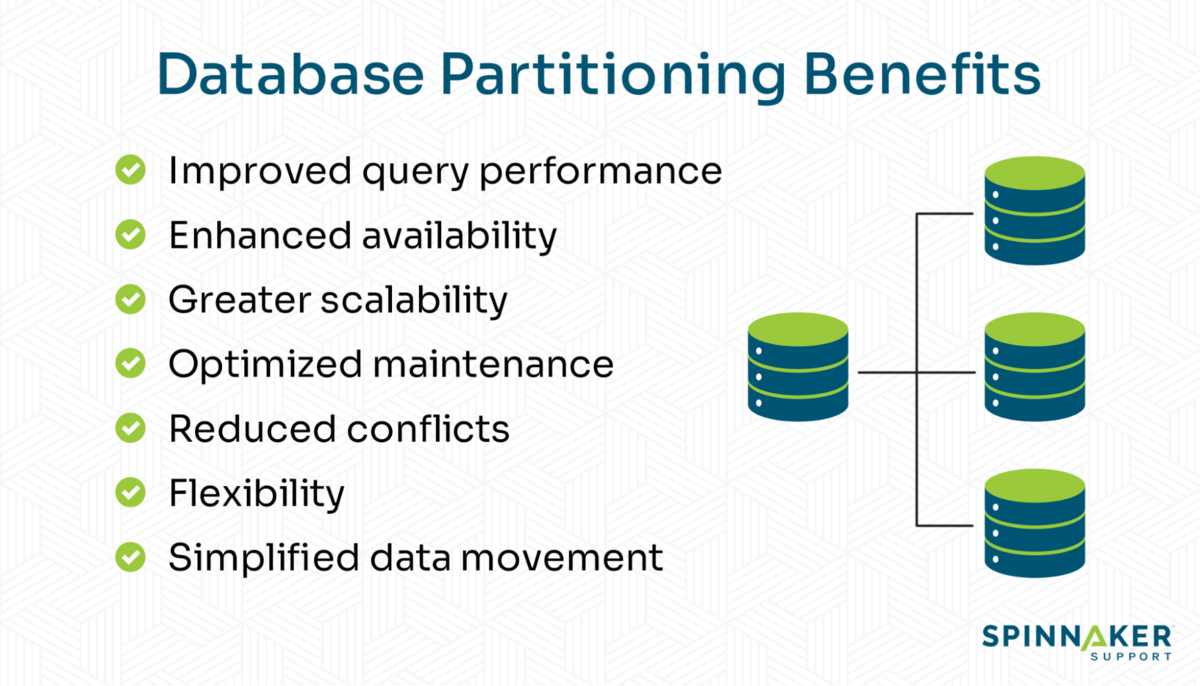
Here’s how partitioning your database can help your company.
Improved query performance
Queries that access a subset of data can be directed to only scan the relevant partitions, reducing input/output (I/O) and improving query response times. For example, queries on recent sales data can avoid scanning historical partitions.
Enhanced availability
Partitioning can reduce downtime if system failures occur. You only have to recover the affected data while the rest remains online and accessible.
Greater scalability
With database partitioning, you can add new partitions to distribute load. This provides a scale-out solution to accommodate growth and large data volumes.
Optimized maintenance
Partition pruning can remove unnecessary data access for rebuilding indexes or integrity checks. This focused maintenance requires fewer resources.
Reduced conflicts
With partitioning, you can separate data from high-activity applications from data requiring more stability. This isolation limits conflicts and disruption.
Flexibility
As data volumes change, you can split partitions to distribute load or merge them to optimize queries. Partitions can have different keys, indexes, and constraints. This provides flexibility to tailor structures according to access patterns for each partition.
Simplified data movement
You can detach and reattach partitions to different databases or servers more easily than to the entire large tables. This facilitates moving data to different storage tiers or platforms.
What are the drawbacks of database partitioning?
While database partitioning can provide significant benefits, it does have some disadvantages.
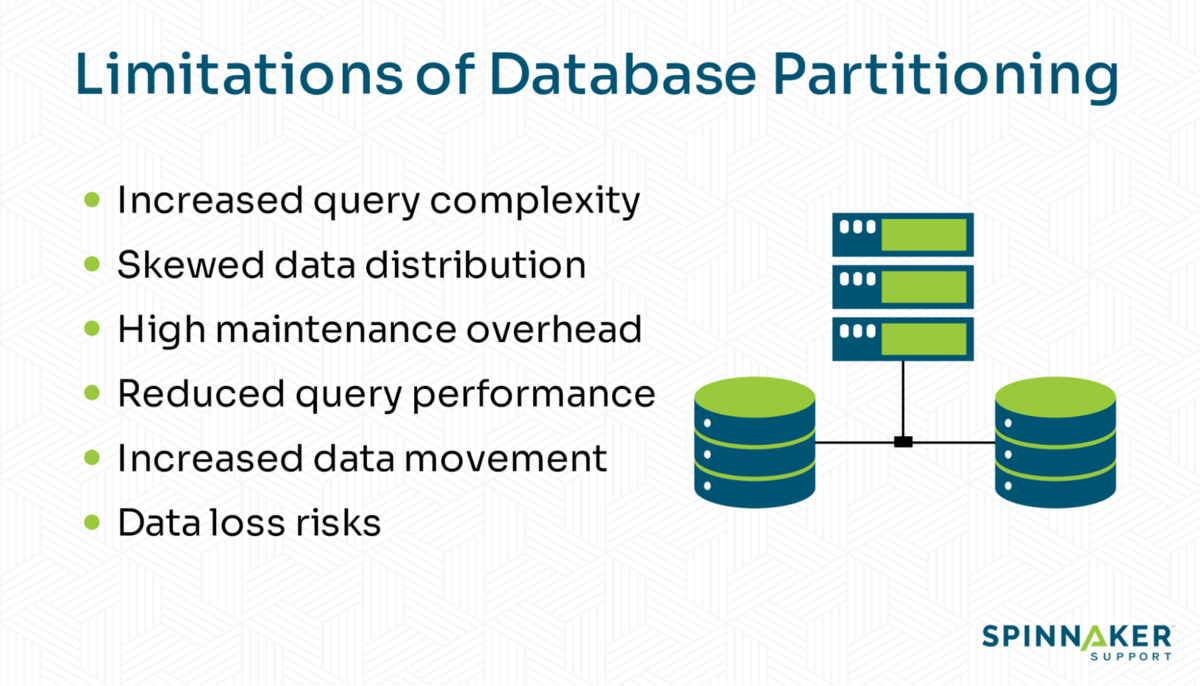
Partitioning can introduce several drawbacks if not planned and implemented carefully.
Increased query complexity
You may need more joins and unions for certain queries, increasing code complexity. For example, reporting queries may need to unite data from monthly sales partitions.
Skewed data distribution
If you don’t choose partition keys wisely, some partitions will be large while others will remain small. This causes imbalances in I/O, memory, and processing.
High maintenance overhead
Coordinating changes across many partitioned objects like tables and indexes can be administratively complex. You require a significant database administration (DBA) effort and frequent reorganizing to fix skewed data distribution.
Another thing to note is that technical troubleshooting and maintenance of Enterprise Resource Planning (ERP) databases can overload internal IT teams. ERP systems contain a complex web of integrated databases powering various business functions.
Using managed services offered by Spinnaker Support is one strategy to alleviate the maintenance burden. Our experts can guide you in proactive tuning, high availability setups, disaster recovery systems, and rapid troubleshooting across ERP database environments.
This allows your internal staff to focus on higher-value strategic initiatives rather than daily database administration overload.
Reduced query performance
If the partitioning scheme doesn’t align with typical query patterns and filters, queries may have to scan many unnecessary partitions, compromising performance.
Increased data movement
Migrating and juggling partitions across storage tiers generates overhead from constant data shuffles. This negates partitioning benefits.
Data loss risks
You can lose all the data if any single partition fails or becomes corrupted. Or bugs in the partitioning logic itself could cause corruption or deletion of records in a certain partition.
With our SpectrumDB managed services services, our experts ave extensive experience in successfully implementing partitioning for various data models and access patterns. We can provide best-practice recommendations for database strategy tailored to an organization’s needs.
For example, we’ve provided our services to 12,000 Oracle database instances.
Our services are ITIL-centered, and our global engineering team consists of Level 2 and Level 3 engineers with 19+ years of experience.
Beyond this, our expert advisors can help analyze risks, design precautions, and review plans to prevent data loss. We also provide support for legacy database products.
Methods of database partitioning
There are many ways you can partition a database.
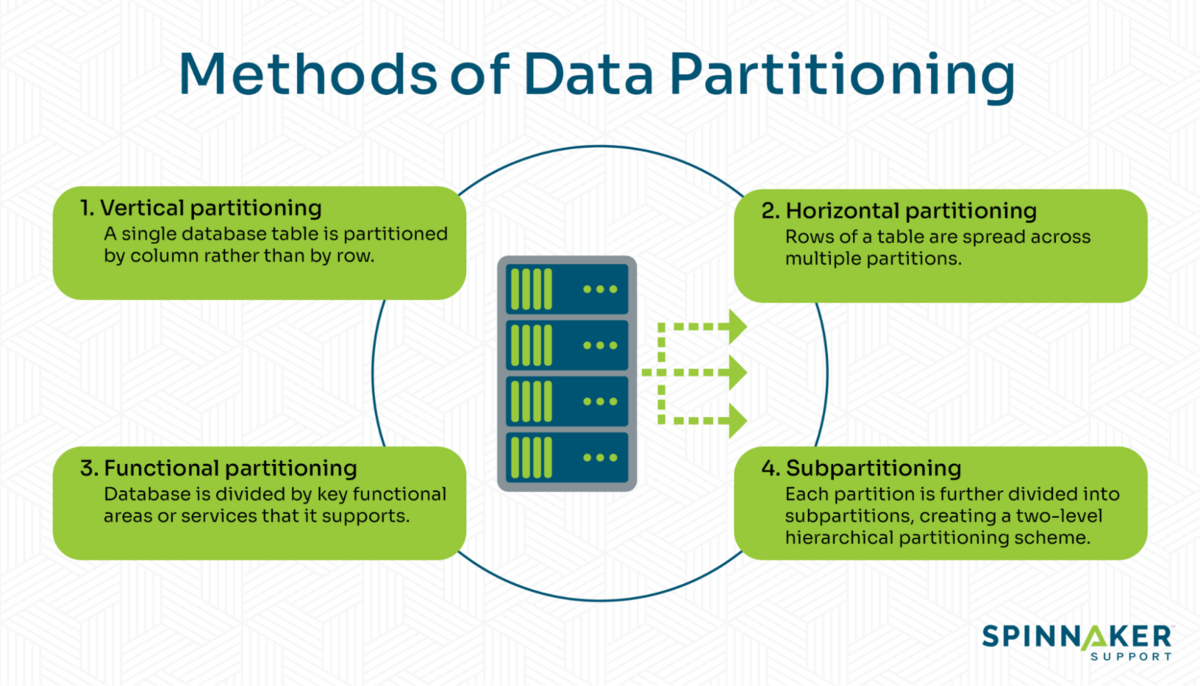
Here are the main database partitioning strategies’ pros, cons, and use cases.
Vertical partitioning
In vertical partitioning, you partition a single database table by column rather than by row. Subsets of columns are split into separate physical partitions or tables, while the original table retains a record ID column to enable joining.
Pros of vertical partitioning:
- Speeds up queries by avoiding scanning irrelevant columns
- Simplifies maintenance like backups and locking on column partitions
The tradeoff is overhead from reconstructing the original table via joins when full data is needed.
Vertical partitioning is helpful when you want to separate frequently and infrequently accessed columns and isolate columns with different access patterns.
Horizontal partitioning
Horizontal partitioning is where you spread rows of a table across multiple partitions according to a partitioning scheme.
Pros of horizontal partitioning:
- Allows pruning partitions during queries and maintenance
- Improves performance through parallel processing
- Enables archiving of old partitions if partitioning by time
The drawback is you may need to resort to joining if a query spans multiple partitions.
Horizontal partitioning is best for managing historical time series and archiving data. For example, a user analytics table grows to 1 billion rows over five years. Horizontal range partitioning divides it by year, so queries for recent data only hit the relevant partitions.
Functional partitioning
Functional partitioning is a database strategy that divides the database by key business functions or services your business supports. For example, functions like orders, inventory, and finance have separate databases.
Pros:
- Simplifies queries focused within a functional area
- Creates physical separation to support decentralized data management
The downside is that it can result in redundant copies of shared data and complicate enterprise-wide operations, reporting, and analytics. The joins are more complex if they cross functional boundaries.
Subpartitioning
Subpartitioning is a technique where you divide each partition further into sub-partitions, creating a two-level hierarchical partitioning scheme.
Pros:
- Enables more granular data management within a partition
- Most major database platforms support it
- Can mitigate some issues of single-level partitioning, like skew
There are certain drawbacks to this strategy. You may also have to sub-partition indexes, increasing index maintenance efforts. Too many small sub-partitions can become difficult to manage.
Data partitioning criteria
In this section, we’ll cover five types of data partitioning criteria.
1. Range partitioning
Range partitioning divides data into partitions based on ranges of values of a partitioning key column like date or ID.
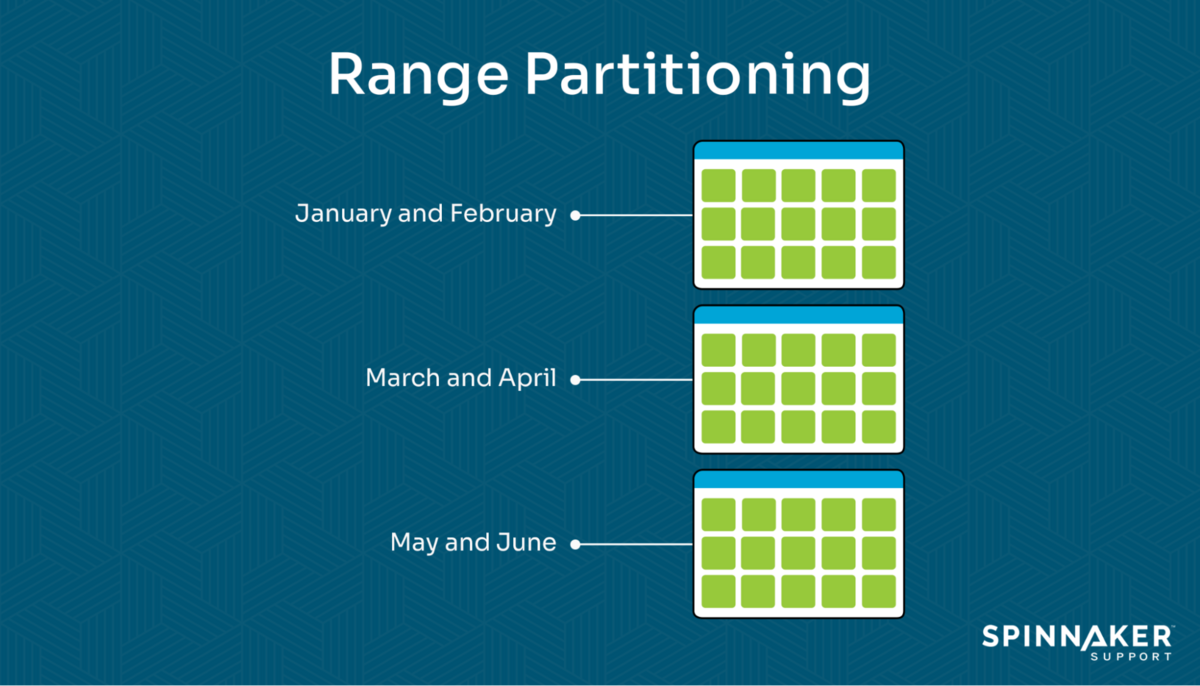
With this method, queries can eliminate irrelevant partitions based on range filters. For example, range partition a sales table by week to optimize weekly reports.
Plus, age-based archiving is straightforward. This method can be particularly beneficial for cloud migration projects as it can make migration more incremental.
There can be a risk of data skew if range sizes vary significantly. Queries spanning ranges can require partition merges.
2. Hash partitioning
Hash partitioning uses a hash function to assign rows to partitions based on the hash key’s values.
Hashing is simple and distributes data uniformly, avoiding skews. For example, you can hash partition a large customer table for balanced storage and I/O. It’s easy to add new partitions.
However, queries for data ranges that span partition boundaries lead to less efficient queries or the need to scan multiple partitions.
3. List-based partitioning
List partitioning explicitly defines partitions based on discrete values the list key column can take. Queries can target specific partition values.
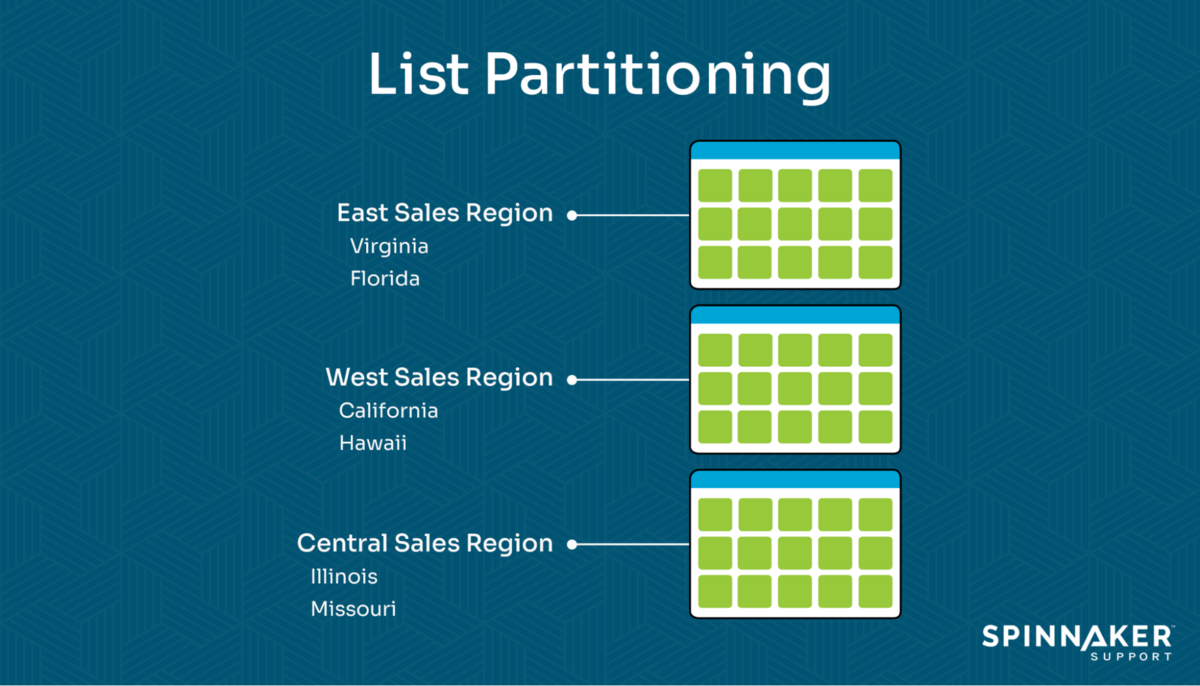
For example, you can list partition product tables on category columns to optimize category-specific operations.
It requires advanced knowledge of partitioning values. Plus, many partitions can become hard to manage.
4. Composite partitioning
Composite partitioning blends multiple techniques like hash partitioning and range partitioning. It tries to get the best out of both.
For example, hash partition a large sales table, then range partition the hashes by week to optimize date range queries.
It can handle a wider variety of query filters through composite schemes. It helps reduce index maintenance overhead.
However, it increases complexity significantly for partitioning, index management, and query optimization.
5. Columnar partitioning
Columnar partitioning stores table columns in separate column-oriented partitions instead of traditional row-oriented storage. This improves analytics query performance.
It improves compression and reduces I/O by reading only relevant columns. Parallel scan of columns is faster.
However, there can be overhead for inserts, updates, and rebuilding columns.
The future of database partitioning
As data volumes grow exponentially, database partitioning is expected to become even more critical for management and system performance.
Automated design tools powered by artificial intelligence may enable real-time partitioning optimized to current access patterns and data characteristics. Schema-on-read architectures (allow data to be ingested and analyzed without a prior schema definition) will allow flexible repartitioning without expensive data movement.
With cloud and serverless technologies, you can seamlessly scale partitions across distributed infrastructure without capacity planning. The database will automatically spawn partitions on serverless nodes in response to usage demand.
The next wave of partitioning innovation will strive to make large-scale distributed data simpler for users.
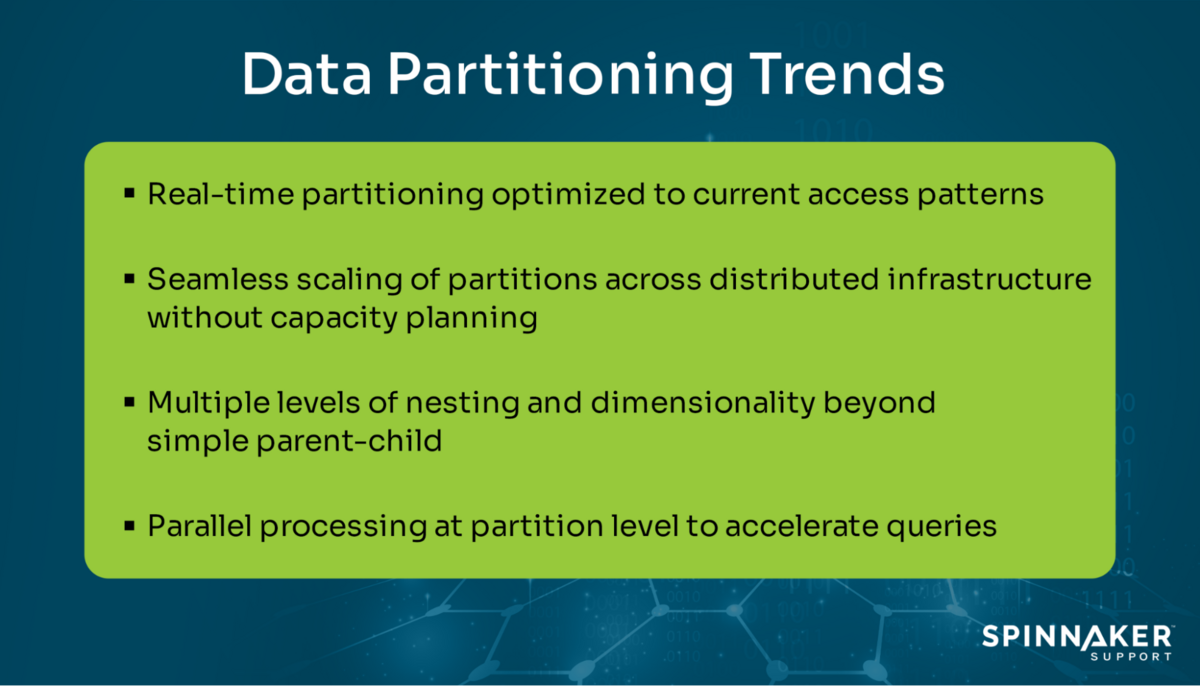
Overall, the industry outlook points to increased use of partitioning, more automation, and smarter multipartitioning strategies. Companies aim to leverage partitioning earlier and manage it holistically across on-prem and cloud environments.
Common FAQs about database partitioning
Still have questions about database partitioning? Here are answers to frequently asked questions.
What is database partitioning vs. sharding?
Database partitioning works within a single database server. It divides database objects like tables and indexes into smaller segments called partitions. Partitioning is managed automatically by the database system. Applications can query partitioned tables normally without any changes.
Sharding takes a different approach. It distributes an entire database across multiple servers. Each server acts as a separate database, managing a subset of the data. Sharding requires applications to be rewritten to understand the data that’s sharded.
What is the difference between database partitioning and indexing in Oracle?
Partitioning in Oracle physically segments tables and indexes for easier data management. Indexing in Oracle creates logical structures for faster data access.
Oracle does automatic partitioning once configured. However, indexes must be manually created.
Partitioning improves query performance by pruning partitions. Indexing speeds up lookups by sorting columns.
What is a database partition key?
The partition key decides which partition each row of data goes into. All the rows with the same key value are put in the same partition.
For example, if “customer_state” is the partition key for a customer table, all the customers from California would be in one partition. Customers from New York would be in a different partition.
This separates the large table into smaller partitions based on the key.
The value of database partitioning and managed services
Database partitioning strategically segments large database objects to optimize performance, availability, and management.
For companies lacking in-house partitioning expertise, leveraging knowledgeable managed services provides cost-effective access to advanced skills.
If you would like any information on Spinnaker Support or our support and services, please reach out to us today!

